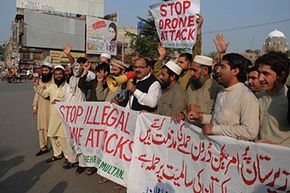A United States Air Force pilot guides his aircraft through dark skies above the Pakistani region of Waziristan. He's not, however, in a cockpit, or even anywhere near the Middle East. He's sitting in a desk chair thousands of miles away at Hancock Field Air National Guard Base outside of Syracuse, New York. In front of the pilot is an array of computer screens displaying maps, video feeds and gauges, which he intently examines while manipulating a joystick and throttle control. While this setup looks like a gamer's paradise, the task is much more sober: remotely killing suspected militants using unmanned combat aerial vehicles (UCAVs) — popularly known as drones.
The pilot watches as five men walk into a small hut made of mud and bricks. As the last one walks through the door, the operator gives the order to fire, and with a push of a button a laser-guided missile drops from the drone and slices through the night.
Advertisement
Meanwhile in the hut, the men are unaware they're being watched. Still, they know drones can strike without warning, so they're a bit anxious as they discuss a plan to bomb polling places during the elections in neighboring Afghanistan. Suddenly, a hissing noise breaks the silence of the evening. Instinctively the men dive for cover, but to no avail; the missile blows the roof off of the hut and shatters all the windows. All five men perish from burns, flying shrapnel and the impact's crushing blast.
This is how drone strikes are supposed to work: The bad guys are identified after careful monitoring and killed with no collateral damage. But if you watch the news much, you know this isn't always the case. Sometimes civilians are hit by accident, enraging entire communities and turning them against the United States. Their government, reacting to the outcry, vows to oppose the drone program. But without the drones, who's going to kill the militants? Clearly, this is an issue that raises incredibly complex questions with few clear answers.
So how did we get to this point? When did drone strikes start? Who uses them? How do drones work? How do they choose targets? Why are people so upset about drone strikes? Those questions do have answers, and we'll explore them in our in-depth look at how drone strikes work.
Advertisement






